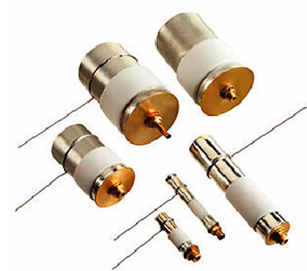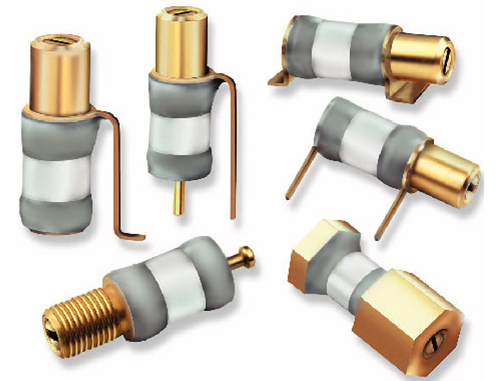In part 1 of this two-part guide, we talked about the trade-offs you need to make when selecting the type of capacitor that will be the best fit for your application and the basics of trimmer capacitor design including dielectric material options. This second post focuses more on the details of trimmer capacitor specs and how to determine what's right for your application.
Understanding Trimmer Capacitor Specifications
Once you have decided a trimmer capacitor is a good fit for your application, there are numerous additional decisions to make. In addition to the many dielectric options, trimmer capacitors are also available in numerous package styles, including those designed for PCB mounting, panel mounting, and surface-mount applications. Trimmer capacitors are even available for low-temperature applications in cryogenic systems and manufactured without magnetic materials for use in critical industrial and medical applications such as MRI systems.
There are also many specifications to consider when comparing trimmer capacitor options including capacitance range, the number of turns required to cover the capacitance range, the SRF, the minimum Q, temperature coefficient, tuning torque, DC working voltage, DWV, and size. When looking at these specs and comparing components from different manufacturers, it is important to normalize values for these characteristics as much as possible since manufacturers may use different reference points for measurements.
For example, when looking at Q, also note the frequency at which it was measured (which can range from 1 to 250MHz) as well as the capacitance at which it was specified. The higher the Q, the higher in frequency a trimmer will operate. Additionally, since Q is a function of frequency that decreases with increasing frequency, any comparison between trimmer capacitors from different suppliers should be referenced to a common frequency such as 1MHz or 100MHz. In addition, you should also note the capacitance value for the SRF, which may also be measured at any capacitance value within the tuning range.
A trimmer capacitor's maximum DC working voltage rating, which is the typical maximum value of continuous voltage for which that component is designed and tested, should also be considered. The DWV is typically twice the value of the maximum working voltage rating and is a short-term value above which damage will usually occur. The voltage rating generally depends on the size of the capacitor and the type of dielectric used in the trimmer capacitor, with high-isolation materials such as PTFE being capable of handling fairly high voltage levels. For example, our NT series of PTFE dielectric trimmer capacitors feature DC working voltage ratings as high as 7,500V and DWVs as high as 15,000V. These capacitors provide capacitance tuning ranges from 2 pF to 100 pF, although the high-voltage rating component is relatively large, measuring about 5 inches long (Figure 2).
 Figure 1. Trimmer capacitors in the NT series feature DC working voltage ratings as high as 7,500V and a DWV as high as 15,000V for a capacitance range of 2 pF to 100 pF.
Figure 1. Trimmer capacitors in the NT series feature DC working voltage ratings as high as 7,500V and a DWV as high as 15,000V for a capacitance range of 2 pF to 100 pF.
While the operating temperature range needs to be a factor, you should also understand the effects of temperature on the trimmer capacitor's set value as represented by the component's temperature coefficient. The temperature coefficient presents a component's amount of capacitance deviation in parts per million (ppm) per degree of temperature change. A smaller value temperature coefficient represents a more stable capacitor. When comparing models from different manufacturers, it is important to compare the temperature coefficient values for the same capacitance range. Additionally, for military applications, trimmer capacitors should be specified according to the required temperature range (–65 to +125°C) as well as to MIL-PRF-14409 specifications which call out screening of parts according to specific levels of mechanical shock and vibration.
Finally, when capacitor size is a crucial factor, there are low-cost chip-size trimmer capacitors available today that can replace fixed-value chip capacitors with little sacrifice in PCB real estate. Our Thin-Trim capacitors are ideal for applications where size and performance are most critical. These single-turn capacitors exhibit remarkable electrical characteristics for their small size and can be used for frequencies up to 2 GHz.
Capacitance Range and Tuning Capabilities
The capacitance range and the number of turns to adjust that range determine the amount of control over a capacitance setting. Trimmer capacitors are available in low-cost models with 1 pF to 2 pF of capacitance and one-half turn to units with tuning ranges to 250 pF and more and multiple turns of adjustment. Put simply, for more control, specify a trimmer capacitor with a greater number of turns for a given capacitance range. For example, our low-cost A1 Series trimmer capacitors includes models with maximum capacitance values of 4 pF, 8 pF, and 12 pF and seven turns for adjusting the two lower pF value models and 13 turns for adjusting the 12 pF model (Figure 3).

Figure 2. Our A1 Series trimmer capacitors includes models with as many as 13 turns for tuning a total capacitance range of 12 pF.
Tuning torque is simply a measure of the force needed to turn a trimmer capacitor's adjustment screw. While this seems obvious, the value should be in a range that provides enough torque to ensure that an adjustment will remain in place once set, yet not so much torque it requires excessive force for tuning. This torque should generally fall in the range of 0.3 to 3.0 inch-ounces.
Working with Knowles Precision Devices to Select the Perfect Trimmer Capacitor
Knowles Precisions Devices is a leader in the design and manufacture of precision trimmer capacitors. Our portfolio of trimmer capacitors includes components made with air, glass, sapphire, and PTFE dielectrics that can be used from 1 MHz to over 2 GHz and at voltages up to 20,000 VDC. Our trimmers are available in precision multi-turn and half-turn formats to accommodate any level of application demand. Our engineering team is well positioned to work with you to recommend or create the perfect trimmer capacitor for your application.
Learn more about our wide range of trimmer capacitor offerings or contact us for more information.

